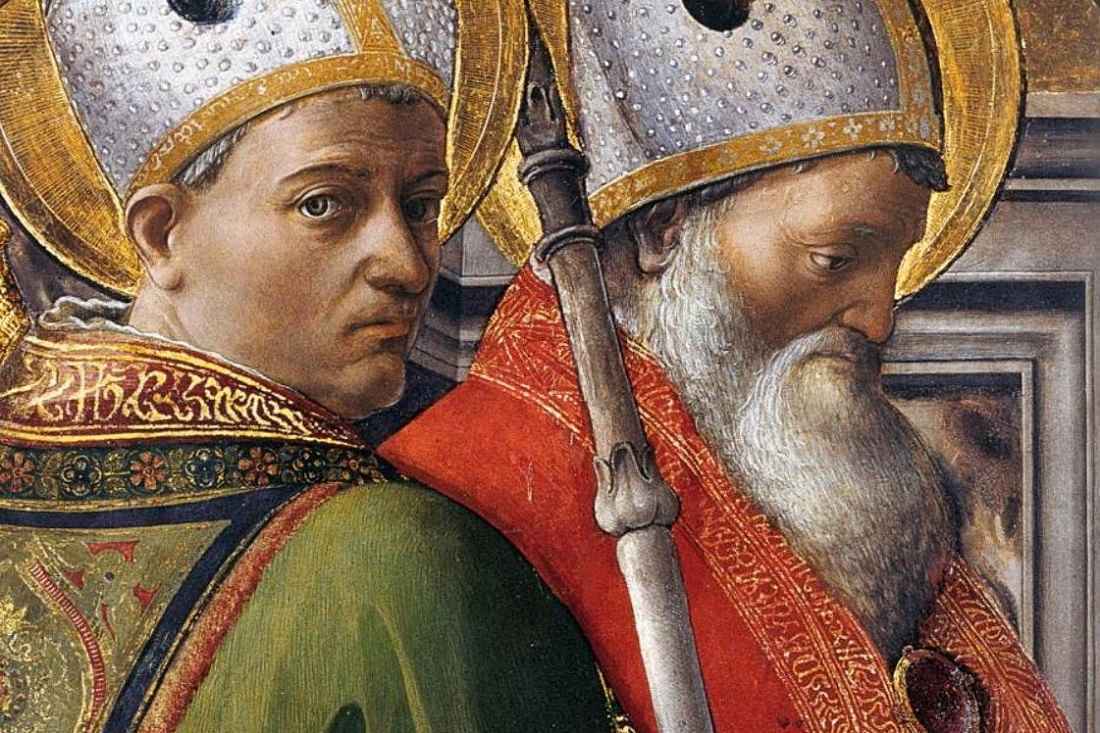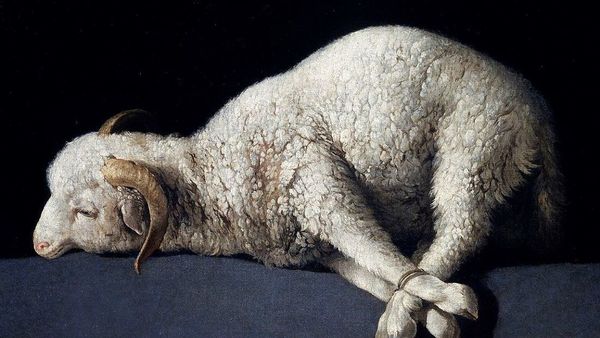During the season of Advent, as we wait for Jesus’s birth, we celebrate saints who imitated Christ: St. Nicholas, of course, but also St. Lucy, St. Ambrose, and St. Anne to name a few. We remember these saints not only as those friends of God who surround us but also as those models who imitated Christ that we may in turn see their imitations and follow. What is the Christian life but the attempt to be like Christ? Which means, as saints on this way, we are always asking ourselves the question, how do we imitate Christ? While the rest of the world prizes a false ideal of originality, the Church exalts imitation. Every year I teach St. Augustine’s Confessions to first-year college students because the spiritual autobiography of the saint calls us to a life of imitation. While St. Augustine is a saint, and the rest of us are still in the process of sanctification, his Confessions, with honesty and vulnerability, reveal what that process looked like for him and might look like for us.
St. Augustine structures his narrative in such a way that his readers may experience the kenotic move of God becoming incarnate, a path that descends before ascension. He is motivated to organize his story in this fashion because of his desire to follow Christ and his belief that such imitation will encourage readers to follow his story. Nearly two millennia later, René Girard would offer us a “mimetic theory” to explain why such rhetorical strategies work.[1] Mimetic theory proposes that humans are imitative by nature: from our infancy, we learn to desire based on what others desire. In Book I of the Confessions St. Augustine depicts mimesis in babies and observes how they react with vice to unmet desires: “I have personally watched and studied a jealous baby. He could not yet speak and, pale with jealousy and bitterness, glared at his brother sharing his mother’s milk.” St. Augustine explains that sin stems from desiring what another has, the envy of the other, as well as from the pride that convinces someone he is the most deserving. In adults, mimesis poses further problems because we sacralize our autonomy.
The opening sentences of Jean-Jacques Rousseau’s Confessions (1782) establish a stark contrast to the goals and intentions of St. Augustine’s spiritual autobiography. As the author of the work, Rousseau asserts originality, dismisses any predecessors, and discourages anyone from following his example:
I have entered upon a performance which is without example, whose accomplishment will have no imitator. I mean to present my fellow-mortals with a man in all the integrity of nature; and this man shall be myself. I know my heart, and have studied mankind; I am not made like any one I have been acquainted with, perhaps like no one in existence; if not better, I at least claim originality, and whether Nature did wisely breaking the mould with which she formed me, can only be determined after having read this work.[2]
As the subject of the work, Rousseau feigns absolute knowledge of himself as well as what constitutes human nature. Rousseau allots approximately 600 pages to divulging the various details of his life—often with inaccuracy—and with no coherence save the implicit Peter-Pan-like crowing, “Oh the cleverness of me!”[3] Like Rousseau, we purport originality, which is undercut if we are all imitative creatures. Ironically, this unique 18th century work draws its title from what many would argue is the more original text, and “a case can be made that Rousseau deliberately wrote his Confessions as a response to the Confessions of St. Augustine.”[4] So much for originality. In the world of his Confessions, St. Augustine is led astray when imitating poor models or desiring earthly and temporal goods, but he also shows the path out of the mimetic contagion, which is to imitate the one in whose image we are made.
As the author of the text, St. Augustine models humility for his readers, especially through his admitted imitation of the saints who have written before him. Although a spiritual autobiography, Confessions does not open with the pronoun “I.” Instead, St. Augustine first addresses God as the “high” one, the “great,” one and places “man,” the community of which he is one part, as the “little piece of your creation.” The ordering is significant because it also denotes the structure of Confessions: the move down which will move St. Augustine up. He signals this descent to ascent trajectory even in these opening lines by exalting God on high and reminding “man” of his lowness. Moreover, the first words of the text are not from St. Augustine but drawn from the Psalms. Within this first paragraph, St. Augustine cites four Scriptural passages, which indicates his desire to imitate these other writers, to pattern their praise of God and invoke their knowledge. As a rhetorician who understood how to present himself and how to appeal to his audience, St. Augustine was intentional with his choices here to grant the first words to other voices.
Furthermore, in the course of Confessions, St. Augustine writes on the persuasive power of texts and their potential to cause negative imitation. He recounts how he wept over Dido in The Aeneid and “gave pride of place in [his] affection to those empty fables.” Although St. Augustine talks elsewhere of the truth to be gleaned from pagan literature,[5] in this first book of the Confessions, he laments that those reading Homer would copy the gods “and anyone who so acted would seem to follow the example not of abandoned men but of the gods in heaven.” St. Augustine fears the power that these Greek and Roman epics hold over readers who will imitate the wrong models. Knowing that texts are capable of such power, St. Augustine crafts his own work in such a way that all elements, from language and syntax to structure to invention will imitate the Incarnation.
In Book IV, St. Augustine describes Christ’s “descent and ascent” and designates this path as that which all Christians should follow: “Come down so that you can ascend and make your ascent to God. For it is by climbing up against God that you have fallen.” In Book VII, St. Augustine uses Philippians 2 as an outline for the route of Incarnation and thus for those who seek to emulate it. He compares and contrasts the passage with the Neoplatonists he read:
In reading the Platonic books I found expressed in different words, and in a variety of ways, that the Son, “being in the form of the Father did not think it theft to be equal with God,” because by nature he is that very thing. But that “he took on himself the form of a servant and emptied himself, was made in the likeness of men and found to behave as a man and humbled himself being made obedient to death, even the death of the Cross so that God exalted him” from the dead “and gave him a name which is above every name, that at the name of Jesus every knee should bow, of celestial, terrestrial, and infernal beings, and every tongue should confess that Jesus is Lord in the glory of God the Father” (Phil. 2:6-11)—that these books do not have.
The Incarnation creates the difference between pagan philosophy and Christian Scripture, for Christ’s descent into human form makes him worthy of exaltation by God. St. Augustine’s journey to conversion is one of descent into the lower orders and then ascent through imitation of Christ.
The Confessions are beset by St. Augustine choosing between higher and lower models to imitate. He begins by modeling those who lead him towards transient goods—those with whom he stole the pears or those “depraved companions,” with whom he “used to pretend” he had committed sins to win their attention. Girardian critic Wolfgang Palaver summarizes it thus, “St. Augustine runs through a series of different role models until he finally converts to Christianity, a process that is incidentally also influenced by the example of others.” St. Augustine laments that in his adolescence, he had no worthy model, for even his father “did not care what character before [God] [that St. Augustine] was developing.” To replace his negligent pagan father, St. Augustine sought intellectual role models, such as the Manicheans, whom he describes as “very earthly-minded” and in whose “mouths were the devil’s traps.” Following these models, St. Augustine embraced earthly utility and descended lower into worldly ways of being.
When St. Augustine preaches, in Book IV, that we should descend in order to ascend, he reflects that, at that point in the narrative, he was unaware of such truth. Rather, his descent began because, as he writes, “I loved beautiful things of a lower order, and I was going down to the depths.” The language of Books I through VII consistently refers to lowness and to the dark depths that St. Augustine sank by chasing the material goods around him. In the famous pear tree episode in which St. Augustine discovers his potential for evil, he describes his heart “at the bottom of the abyss,” and later he confesses the steps which brought him “down to the depths of hell.” St. Augustine concludes that such depths are reached by poor imitation and the desire to ascend against God: “In their perverted way all humanity imitates you. Yet they put themselves at a distance form you and exalt themselves against you.” The human desire to be like God may be perverted into a desire to become a god oneself; this desire, St. Augustine notes, propels humans lower rather than higher. St. Augustine wasted nine years trying to exalt his status, only to wallow in mire.
In Books VI through VIII of the Confessions, St. Augustine records the process by which he came to the seemingly sudden moment of his conversion, and readers realize that one’s ascent to God is paradoxically gradual and yet instant. Like St. Augustine’s earlier descent, his draw upwards is initiated by models. In contrast to those models that led St. Augustine downward, however, these models renounce earthly status and possessions, and thus are exalted upwards. We listen as Simplicianus (who will be Ambrose’s successor) relates the story of Victorinus—a rhetorician like St. Augustine who has hidden his Christian conversion to avoid public shame. When St. Augustine hears that Victorinus has proclaimed his faith before a crowd, he admits, “I was ardent to follow his example.” St. Augustine recognizes that Simplicianus intended for St. Augustine to feel this way following the tale: “He had indeed told it to me with this object in view.” Here, we see not only a model in Victorinus as someone St. Augustine should follow, but also Simplicianus becomes a model for St. Augustine the author of Confessions who hopes his readers may be as transformed by the telling of his conversion.
Book VIII, in which the conversion occurs, has layers upon layers of imitation. Although St. Augustine initially desires to become a Christian follower, after hearing of Victorinus, he does not act upon this inclination until he hears the influence that the life of St. Antony, the Egyptian monk, has had on others. When his African compatriot Ponticianus visits unexpectedly, he relates the story of how Antony converted him to Christianity; Antony was transformed by the gospel story in which Jesus tells a rich young ruler to sell everything he owns and follow him (See: Matt 19:16-22). The first model is Christ who gives up everything to follow the will of his Father. Then, Antony imitates Christ, who is imitated by Ponticianus, who inspires St. Augustine to imitate him. Whereas the desire for earthly goods leads to competition rather than imitation, the renunciation of earthly goods by each of these followers encourages others to imitate them.
For St. Augustine, these stories compel him to descend both literally and figuratively. St. Augustine ventures into the garden and throws himself down beneath a fig tree, an action corresponding to his figurative descent into humility. The conversion takes place in a garden, a scene resonant of both Adam’s fall and Jesus’s prayer in Gethsemane. By choosing the garden setting, St. Augustine intentionally calls these previous stories to his readers’ minds. He is aware of the need to imitate these stories in order to compel his readers to imitate him. Following this volitional descent in the garden, a voice commands that St. Augustine “pick up and read,” to which he responds by rising, reading in silence, and reads no further because he decides to follow Christ. The reading “in silence” is also indicative of imitation, for St. Augustine comments with great curiosity about Ambrose’s habit of reading silently, which was uncommon at this time.
Even this element of St. Augustine’s conversion reveals new models of imitation. By imitating those who renounce everything, St. Augustine escapes the pride that has imprisoned him, to use one his earlier metaphors, as well as the chains caused by his love of earthly goods. Only when St. Augustine determines to descend and intentionally lower himself before God does he then paradoxically ascend to be like God.
Reconsidering St. Augustine’s Confessions should highlight why we read stories of saints’ lives as part of our devotional practice, especially during Advent, as we look forward to the birth of Jesus, the paradigmatic model of humility. What could more strongly confront our unhealthy desire for exaltation than remembering that God descended from his throne in heaven where he was surrounded by angels singing of his glory to the confined flesh of a wailing infant, neglected by the city, born in a stable, surrounded by vacant-eyed animals? In the Confessions St. Augustine invites the reader to practice such humility. In reading the saint’s confession, we too call God our “Master,” remembering we are “human hauling deathliness in a circle . . . the evidence that [God] stand[s] against the proud.” Our imitation begins by surrendering to St. Augustine’s story, experiencing his descent and ascent, remembering our own, and practicing such a descent daily. All this, so we may sing, in St. Augustine’s company, and in the company of all the saints, “O Come, O Come, Emmanuel.”
[1] In his delineation of Girard’s mimetic theory, Wolfgang Palaver calls St. Augustine Girard’s “great first predecessor” and points out that “Girard concedes in Quand ces choses commenceront ‘three-fourths of that which I have said is already found in St. Augustine.’” René Girard’s Mimetic Theory (Lansing, MI: MSUP, 2013), 88.
[2] Jean Jacques Rousseau, The Confessions of Jean Jacques Rousseau, Ebook #3913, October 4, 2006.
[3] In the original Peter Pan narrative, the young hero delights in his own self-absorption, exclaiming, “How clever I am!” or “Oh, the cleverness of me!” The narrator observes, “[T]here never was a cockier boy” (21). J.M. Barrie, Peter Pan (New York: Henry Holt, 1987).
[4] Ann Hartle, “St. Augustine and Rousseau: Narrative and Self-Knowledge in the Two Confessions.” The Augustinian Tradition (Oakland, CA: California, 1998), 263-303.
[5] In chapter 40 of De Doctrina Christiana, St. Augustine uses the analogy of the Hebrews stealing gold from the Egyptians to relate to how Christians should pilfer truth from pagan stories, for all good things belong to God.


